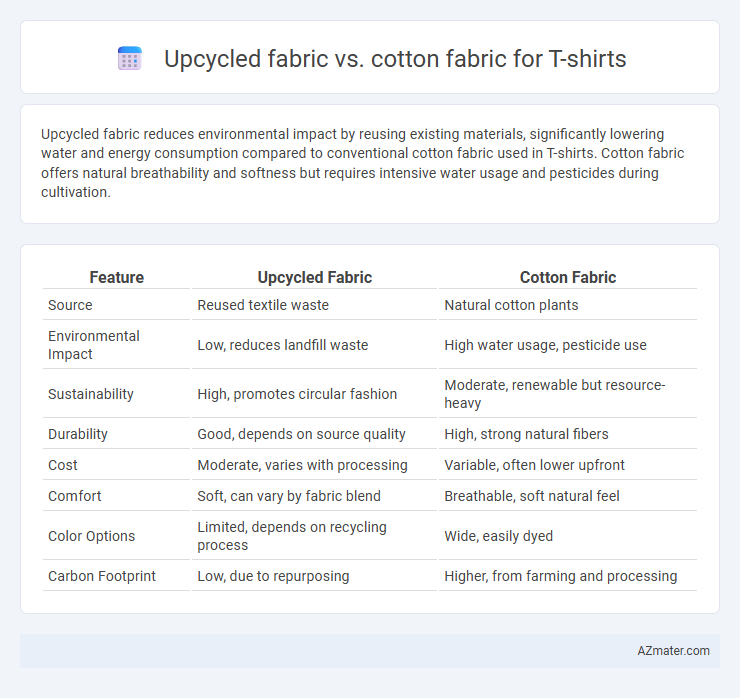Upcycled fabric reduces environmental impact by reusing existing materials, significantly lowering water and energy consumption compared to conventional cotton fabric used in T-shirts. Cotton fabric offers natural breathability and softness but requires intensive water usage and pesticides during cultivation.
Table of Comparison
| Feature | Upcycled Fabric | Cotton Fabric |
|---|---|---|
| Source | Reused textile waste | Natural cotton plants |
| Environmental Impact | Low, reduces landfill waste | High water usage, pesticide use |
| Sustainability | High, promotes circular fashion | Moderate, renewable but resource-heavy |
| Durability | Good, depends on source quality | High, strong natural fibers |
| Cost | Moderate, varies with processing | Variable, often lower upfront |
| Comfort | Soft, can vary by fabric blend | Breathable, soft natural feel |
| Color Options | Limited, depends on recycling process | Wide, easily dyed |
| Carbon Footprint | Low, due to repurposing | Higher, from farming and processing |
Introduction: Upcycled Fabric vs Cotton Fabric for T-Shirts
Upcycled fabric for T-shirts is created by repurposing pre-existing textiles, significantly reducing waste and environmental impact compared to conventional cotton fabric, which requires extensive water, pesticide use, and land resources. Cotton fabric, while breathable and soft, contributes to deforestation and large greenhouse gas emissions during cultivation and processing. Choosing upcycled fabric supports sustainable fashion by minimizing resource consumption and promoting circular economy principles.
What is Upcycled Fabric?
Upcycled fabric is created by repurposing existing textiles or garments, reducing waste and environmental impact compared to traditional cotton fabric, which is made from new cotton fibers. This sustainable approach minimizes water usage, chemical inputs, and carbon emissions associated with cotton cultivation and processing. Upcycled fabric offers an eco-friendly alternative for T-shirts, combining fashion with conscious resource management.
Understanding Conventional Cotton Fabric
Conventional cotton fabric, derived from natural cotton fibers, is widely used for T-shirts due to its softness, breathability, and comfort. However, cotton cultivation demands extensive water usage, pesticides, and land, contributing significantly to environmental degradation. Understanding these factors highlights the importance of exploring sustainable alternatives like upcycled fabric to reduce the ecological footprint of apparel production.
Environmental Impact: Upcycled vs Cotton
Upcycled fabric significantly reduces environmental impact by repurposing existing materials, minimizing waste, and lowering the demand for water, pesticides, and energy compared to conventional cotton fabric production. Cotton cultivation requires extensive water use--about 2,700 liters per kilogram--and contributes to soil degradation and pesticide pollution. Choosing T-shirts made from upcycled fabric supports sustainable fashion by reducing landfill contributions and conserving natural resources.
Durability and Quality Comparison
Upcycled fabric used in T-shirts often incorporates reinforced fibers from pre-existing textiles, enhancing durability by reducing wear and tear compared to conventional cotton fabric. Cotton fabric, prized for its natural breathability and softness, may degrade faster with repeated washing and friction, especially if it is lower quality or untreated. High-quality upcycled fabrics can match or exceed cotton's longevity while supporting sustainable production practices, making them a durable and eco-friendly choice for T-shirts.
Aesthetic Appeal and Style Differences
Upcycled fabric T-shirts often exhibit unique patterns and textures due to the reuse of diverse textile sources, offering a distinctive, eco-conscious aesthetic that appeals to sustainable fashion enthusiasts. Cotton fabric T-shirts provide a classic, smooth look with consistent color and weave, allowing for a versatile and timeless style that suits a wide range of wardrobe essentials. The choice between upcycled and cotton fabrics impacts not only the visual texture but also the storytelling element embedded in the garment's design.
Cost Considerations and Affordability
Upcycled fabric offers a cost-effective alternative to traditional cotton fabric for T-shirts by reducing raw material expenses through the reuse of pre-existing textiles. Cotton fabric, while widely available, often incurs higher costs due to agricultural inputs, water usage, and processing requirements. Choosing upcycled fabric can lead to significant savings and enhanced affordability without compromising quality or style.
Comfort and Breathability Factors
Upcycled fabric for T-shirts often retains the softness and durability of original textiles while promoting environmental sustainability by reducing waste, yet it may vary in breathability depending on the source material's fiber content. Cotton fabric remains the benchmark for comfort and breathability due to its natural fibers that allow air circulation and moisture absorption, making it ideal for sensitive skin and hot climates. Choosing between upcycled and cotton fabrics involves considering the specific blend and processing methods, as upcycled fabrics can be engineered for comparable comfort with a lower environmental footprint.
Ethical and Social Implications
Upcycled fabric for T-shirts significantly reduces textile waste and lowers environmental impact by repurposing existing materials, promoting sustainable fashion practices. Cotton fabric, while natural and biodegradable, often involves intensive water use, pesticide exposure, and labor concerns in cotton farming regions, raising ethical questions about worker conditions. Choosing upcycled fabrics supports circular economy principles and enhances social responsibility by minimizing resource exploitation and encouraging fair production methods.
Choosing the Right Fabric for Your T-Shirt
Upcycled fabric offers an eco-friendly alternative to conventional cotton fabric, reducing waste by repurposing textile scraps into unique, sustainable T-shirts. Cotton fabric provides breathability and softness, favored for comfort and durability but has a higher environmental footprint due to water and pesticide use. Choosing the right fabric depends on prioritizing sustainability with upcycled materials or opting for the natural comfort of cotton, balancing environmental impact and wearability.

Infographic: Upcycled fabric vs Cotton fabric for T-shirt
 azmater.com
azmater.com